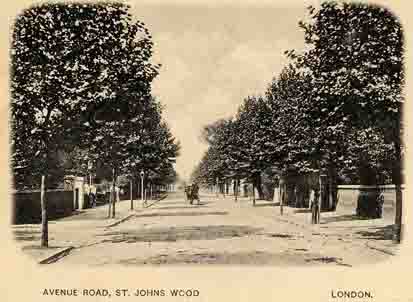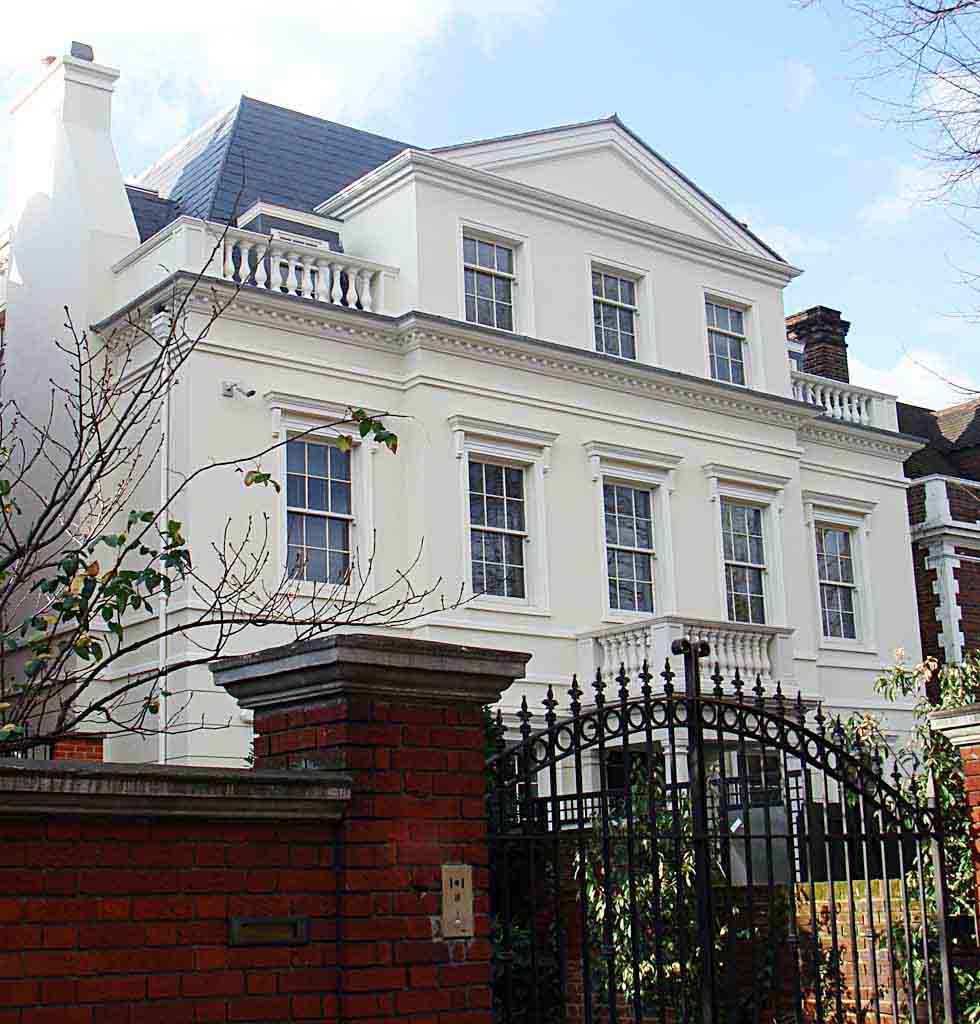WILKIE COLLINS AND ST JOHN'S WOOD
[ Front Page ] [ Collins's main homes ]
According to estate agent Albert Cox's 1853 Landlord and Tenant's Guide...A Gazetteer of Great Britain "St John's Wood is that district north-west of London which lies between the Regent's Park and Maida Hill, and is so much enlarging in the northern direction, that the definition of its locality will shortly be more accurate when stated as lying between Haverstock Hill and Kilburn."
|
|
|
Avenue Road, St John's Wood, in the nineteenth century. |
|
|
|
|
20 (now 39) Avenue Road. Image courtesy of Paul Lewis. |
20 (39) Avenue Road - rebuilt in 2008 |
Wilkie Collins lived for most of his life within easy walking distance of St John's Wood, in and around Marylebone. His first school was the Maida Hill Academy on the western edge of St John's Wood. Between 1838 and 1840 he resided with his family at 20 Avenue Road (now renumbered 39). From The Memoirs of William Collins, R. A. we learn that Wilkie's father was required "...to find a new abode. This was, after some trouble, accomplished by engaging a convenient dwelling in the Avenue Road, Regent's Park - precisely in the quiet situation, on the outskirts of London, which Mr Collins desired to occupy."
After William Collins's death in 1847, Wilkie moved with his mother and brother to 38 Blandford Square during the summer of 1848. This was followed by a move to 17 Hanover Terrace on the western side of Regent's Park in 1850.
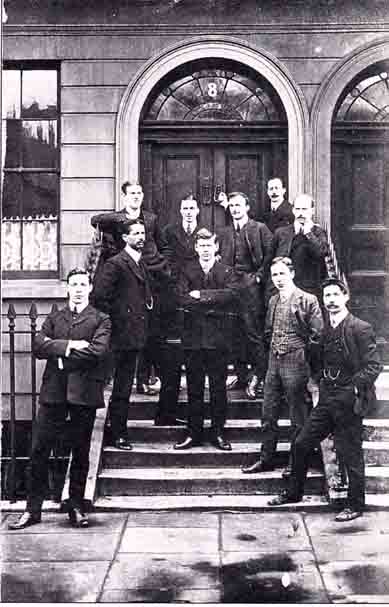 |
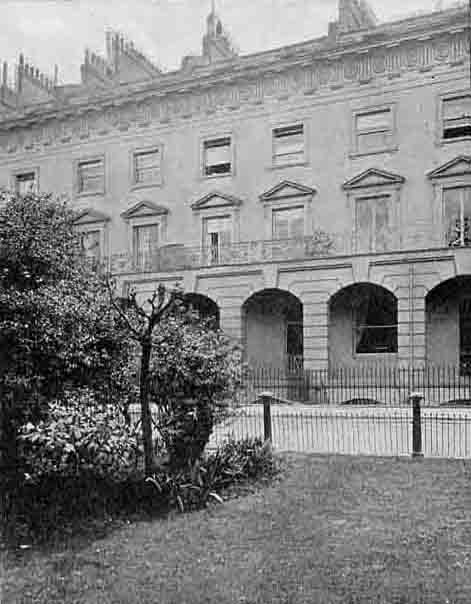 |
| Blandford Square | Hanover Terrace |
Collins had many friends and acquaintances in the St John's Wood area. Douglas Jerrold, the publisher of his first recorded article, 'The Last Stage Coachman', lived at 15 Circus Road. Other friends resident in the area were W. P. Frith, the painter who at different times lived at 12 Park Village West and 114 Clifton Hill; G. H. Lewis who also lived in Blandford Square and to whom Collins was a regular visitor at his soirees and Charles Fechter, the actor who played Obenreizer in No Thoroughfare and with whom Collins collaborated for Black and White. Collins wrote in his 'Recollections of Charles Fechter':
"There is a little villa in the northwester suburb of London, close to the eastern extremity of St John's Wood Road, which I can never pass now without a feeling of sadness. It is the house last inhabited by Fechter in his sojourn in England. Here we feasted and laughed and revelled in some of the brightest social enjoyments that life can afford." Collins intended to recommend Fechter's cook to his friends, the Lehmanns, writing "The French woman who cooked for him - one of the finest artists that ever handled a saucepan - is dismissed in disgrace. You must not think of engaging her. She has done all sorts of dreadful things. Alas! such but too frequently is the fatal gift of Genius!"
![]()
St John's Wood features in several of Collins's books and stories:
BASIL (1852)
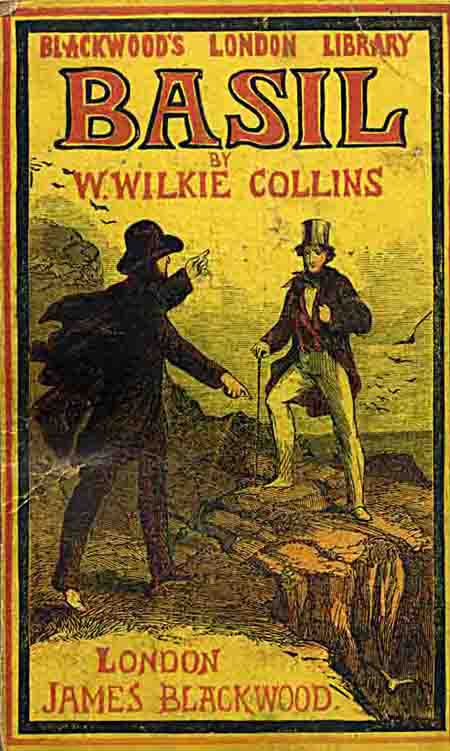
In Basil (1852) the eponymous hero falls in love at first sight with Margaret Sherwin whom he sees on a London omnibus:
"We had nearly arrived at the last point to which the omnibus would take us, when she and her companion got out. I followed them, cautiously and at some distance. She was tall - tall at least for a woman. There were not many people in the road along which we were proceeding; but even if there had been, far behind as I was walking, I should never have lost her - never have mistaken any one else for her. Already, strangers though we were, I felt that I should know her, almost at any distance, only by her walk.
They went on, until we reached a suburb of new houses, intermingled with wretched patches of waste land, half built over. Unfinished streets, unfinished crescents, unfinished squares, unfinished shops, unfinished gardens, surrounded us. At last they stopped at a new square, and rang the bell at one of the newest of the new houses. The door was opened, and she and her companion disappeared. The house was partly detached. It bore no number; but was distinguished as North Villa. The square - unfinished like everything else in the neighbourhood - was called Hollyoake Square.
I noticed nothing else about the place at that time. Its newness and desolateness of appearance revolted me, just then. I had satisfied myself about the locality of the house, and I knew that it was her home; for I had approached sufficiently near, when the door was opened, to hear her inquire if anybody had called in her absence. For the present, this was enough. My sensations wanted repose; my thoughts wanted collecting. I left Hollyoake Square at once, and walked into the Regent's Park, the northern portion of which was close at hand."
'THE BITER BIT' (1856)
'The Biter Bit' sets much of the action in St John's Wood.
There is evidently a third ruffian, a nameless desperado, concerned in the business. "Meet us to-morrow," says Jack, "and judge for yourself. Be in the Regent's Park at eleven in the morning, and look out for us at the turning that leads to the Avenue Road."
"I could go to the world's end with that woman if Mr. Yatman would only die. I sent off the two subordinates to wait until I wanted them at the Avenue Road gate of the Regent's Park. Half-an-hour afterward I was following the same direction myself at the heels of Mr. Jay."
"They had seen the man named "Jack" leave the woman at the gate of an apparently respectable villa residence not far from the Regent's Park. Left to himself, he took a turning to the right, which led to a sort of suburban street, principally inhabited by shopkeepers. He stopped at the private door of one of the houses, and let himself in with his own key"
"If the office approves of my conduct, I have my plan ready for further proceedings. If the office blames me, I shall take myself off, with my marketable information, to the genteel villa residence in the neighborhood of the Regent's Park."
"I'm off to do a little detective business on my own account, in the neighbourhood of the Regent's Park."
THE WOMAN IN WHITE (1860)
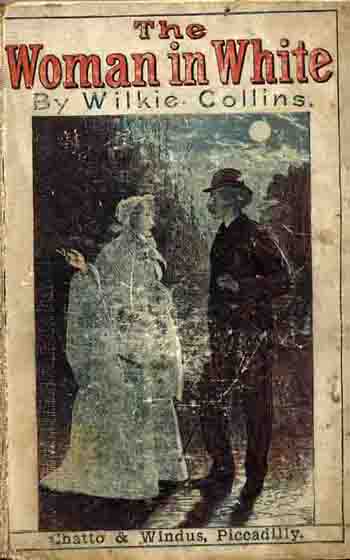
An incident recorded in J. G. Millais's 1899 Life and Letters of Sir John Everett Millais records an incident which is usually taken as the origin of The Woman in White. Current thinking regards the episode as the dramatic way in which Collins introduced Caroline Graves to his friends and family.
"One night in the fifties Millais was returning home to Gower Street from one of the many parties held under Mrs Collins's hospitable roof in Hanover Terrace, and, in accordance with the usual practice of the two brothers, Wilkie and Charles, they accompanied him on his homeward walk through the dimly-lit, and in those days semi-rural, roads and lanes of North London. It was a beautiful moonlight night in the summer time, and as the three friends walked along chatting gaily together, they were suddenly arrested by a piercing scream coming from the garden of a villa close at hand. It was evidently the cry of a woman in distress; and while pausing to consider what they should do, the iron gate leading to the garden was dashed open, and from it came the figure of a young and very beautiful woman dressed in flowing white robes than shone in the moonlight. She seemed to float rather than to run in their direction, and, on coming up to the three young men, she paused for a moment in an attitude of supplication and terror. Then, seeming to recollect herself, she suddenly moved on and vanished in the shadows cast upon the road.
"What a lovely woman!" was all Millais could say. "I must see who she is and what's the matter," said Wilkie Collins as, without another word, he dashed off after her. His two companions waited in vain for his return, and next day, when they met again, he seemed indisposed to talk of his adventure. They gathered from him, however, that he had come up with the lovely fugitive and heard from her own lips the history of her life and the cause of her sudden flight. She was a young lady of of good birth and position, who had accidentally fallen into the hands of a man living in a villa in Regent's Park. There for many months he kept her prisoner under threats of violence and mesmeric influence of so alarming a character that she dared not attempt to escape, until, in sheer deperation, she fled from the brute, who, with a poker in his hand threatened to dash her brains out. Her subsequent history, interesting as it is, is not for these pages."
In The Woman in White Collins transposes this incident about two miles further north, where Frognal Lane and West End Lane meet Finchley Road at the western edge of Hampstead. Walter Hartright records that:
"I determined to stroll home in the purer air by the most roundabout way I could take; to follow the white winding paths across the lonely heath; and to approach London through its most open suburb by striking into the Finchley Road, and so getting back, in the cool of the new morning, by the western side of the Regent's Park .... I had now arrived at that particular point of my walk where the four roads meet - the road to Hampstead, along which I had returned, the road to Finchley, the road to West End, and the road back to London ..... There, in the middle of the broad, bright high-road - there, as if it had at that moment sprung out of the earth or dropped from the heaven - stood the figure of a solitary Woman, dressed from head to foot in white garments."
"Did you hear me?" she said, still quietly and rapidly, and without the least fretfulness or impatience. "I asked if that was the way to London."
"Yes," I replied, "that is the way: it leads to St John's Wood and the Regent's Park.
![]()
Later in the novel, Fosco describes how he intends to bring Laura to London (where he will substitute her for Anne Catherick:
"You object, again, that she cannot comfortably stop and rest in London, on her way here, because she cannot comfortably go alone to a public hotel where she is a total stranger. In one breath, I grant both objections - in another breath, I remove them. Follow me, if you please, for the last time. It was my intention, when I returned to England with Sir Percival, to settle myself in the neighbourhood of London. That purpose has just been happily accomplished. I have taken, for six months, a little furnished house in the quarter called St. John's Wood. Be so obliging as to keep this fact in your mind, and observe the programme I now propose. Lady Glyde travels to London (a short journey) - I myself meet her at the station - I take her to rest and sleep at my house, which is also the house of her aunt - when she is restored I escort her to the station again..."
After Anne Catherick has died and her identity substituted for Laura, the novel gives 'The Narrative of the Doctor':
"To the Registrar of the Sub-District in which the undermentioned death took place. - I hereby certify that I attended Lady Glyde, aged Twenty-One last Birthday; that I last saw her on Thursday the 25th July 1850; that she died on the same day at No. 5 Forest Road, St. John's Wood, and that the cause of her death was Aneurism. Duration of disease not known.
(Signed) Alfred Goodricke. Profl. Title. M.R.C.S. Eng., L.S.A. Address, 12 Croydon Gardens, St. John's Wood.
![]()
At the end of the novel, Walter Hartright goes to Focso to restore Laura's identity:
"The rapid motion of the cab, the sense that every instant now was bringing me nearer to the Count, the conviction that I was embarked at last, without let or hindrance, on my hazardous enterprise, heated me into such a fever of excitement that I shouted to the man to go faster and faster. As we left the streets, and crossed St. John's Wood Road, my impatience so completely overpowered me that I stood up in the cab and stretched my head out of the window, to see the end of the journey before we reached it. Just as a church clock in the distance struck the quarter past, we turned into the Forest Road. I stopped the driver a little away from the Count's house, paid and dismissed him, and walked on to the door."
![]()
There are further mentions of St John's Wood in the later novels:
THE EVIL GENIUS (1886)
"On the voyage home, Beljames told me that a legacy had been left to him; being a small freehold house and garden in St. John's Wood, London. His agent, writing to him on the subject, had reported the place to be sadly out of repair, and had advised him to find somebody who would take it off his hands on reasonable terms. This seemed to point to a likelihood of his being still in London, trying to sell his house.
"Remember Number 12, Purbeck Road, St. John's Wood. Go to the summer-house in the back garden. Count to the fourth plank in the floor, reckoning from the side wall on the right as you enter the summer-house. Prize up the plank. Look under the mould and rubbish. Find the diamonds.
"As thoroughly worthy of each other as ever, the betrothed lovers distrusted each other to the last. At eleven o'clock the next morning they were united in the bonds of wedlock; the landlord and the landlady of the public-house in which they had both served being the only witnesses present. The children were not permitted to see the ceremony. On leaving the church door, the married pair began their honeymoon by driving to St. John's Wood. A dirty printed notice, in a broken window, announced that the House was To Let; and a sour-tempered woman informed them that they were free to look at the rooms."
THE FALLEN LEAVES (1879)
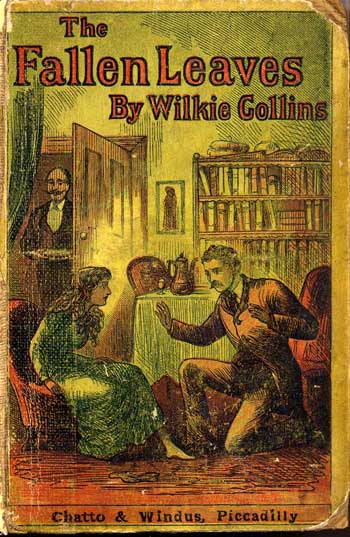
"Regina changed the subject in despair. She asked Amelius if he had found new lodgings. Hearing that he had not yet succeeded in the search for a residence, she opened a drawer of her work-table, and took out a card.
"The brother of one of my schoolfellows is going to be married," she said. "He has a pretty bachelor cottage in the neighbourhood of the Regent's Park - and he wants to sell it, with the furniture, just as it is. I don't know whether you care to encumber yourself with a little house of your own. His sister has asked me to distribute some of his cards, with the address and the particulars. It might be worth your while, perhaps, to look at the cottage when you pass that way."
"It was a fairly fine day. He turned northward towards the Regent's Park. The cottage was in a by-road, just outside the park: a cottage in the strictest sense of the word. A sitting-room, a library, and a bedroom - all of small proportions - and, under them a kitchen and two more rooms, represented the whole of the little dwelling from top to bottom. It was simply and prettily furnished; and it was completely surrounded by its own tiny plot of garden-ground. The library especially was a perfect little retreat, looking out on the back garden; peaceful and shady, and adorned with bookcases of old carved oak."
[ Front Page ]
